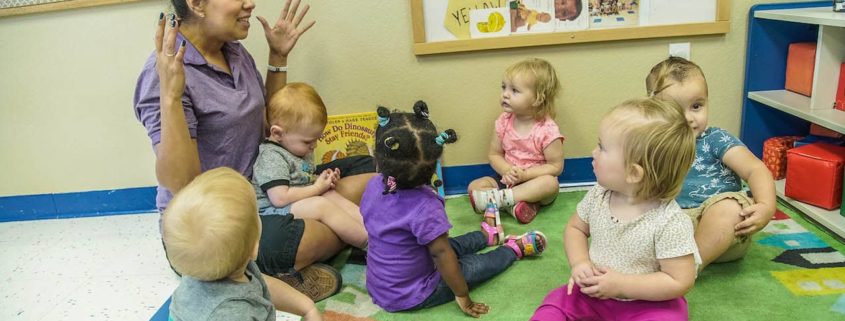There’s so much going on for a two-year-old child who’s absorbing every bit of information around them while relishing the joys of independence. At this age, parents can expect to encounter big feelings and a lot of talking and movement. For those just figuring out parenting themselves — or even the most experienced ones — setting a daily routine can help rein in those sudden emotional outbursts and make days a bit more predictable.
This guide discusses tips on creating a two year old’s schedule, and how partnering with a daycare can help make things so much easier.
Why Structure is Important for 2 Year Olds
How essential is a schedule for toddlers? Small children who have routines tend to feel more stable, secure, and trusting of their parents and caregivers. Because toddlers are still developing a deeper grasp of the events around them, a schedule can also help them understand what is expected of them, so they can behave accordingly.
Setting a daily schedule for a two-year-old child brings many benefits for both the child and the parent or caregiver, including:
Stable body clock
A consistent routine can help children and their bodies get accustomed to daily basics, such as eating healthy and full meals, taking naps and sleeping well at night, enjoying outdoor time and play, following a regular potty time, and staying relaxed and calm during down times.
Social, cognitive, and emotional development
Routines that are predictable, have the right transition cues, and offer enough room for flexibility can help reduce tantrums and other challenging behaviors. Children with routines are often more engaged with the people around them and their environment and respond more positively in case changes happen.
Established expectations
Schedules teach small children to expect certain activities for the day, so there’s less of a power struggle when, for example, toys need to be packed away for nap time or when it’s time for a bath. It’s also good for the busy parent or caregiver because a routine serves as a reminder of important tasks, like ensuring the child takes their vitamins, doesn’t miss a daycare activity, or doesn’t run out of milk and healthy snacks. A schedule creates a calmer household, reducing anxiety and stress for both the child and the parent.
Stable learning environment
Everyday routines offer plenty of teaching moments for two year olds. For instance, you can teach young children to brush their teeth before sleeping or wash their hands before eating. Each activity on the schedule is also an opportunity to chat and ask questions/provide answers to help them develop academically and build strong communication skills.
Sample Daily Schedule for 2 Year Olds
Parents benefit a lot from enrolling their little kids to daycare. The kind of structure that experienced early learning providers create helps busy caregivers get on with their work day while ensuring that children also develop the right way. If you are considering enrolling your child in daycare, here’s an example of a schedule your two-year-old child may have.
Morning
- 9:00 AM – Arrival and breakfast time. Children are greeted by their teachers as they arrive and can play quietly while waiting for their friends to come.
- 9:00 AM to 9:15 AM – Time for a healthy snack to start the day right.
- 9:15 AM to 9:30 AM – Circle time. Start the day as a group and talk about what’s in store for the day. You can sing songs, share stories, or read a book out loud.
- 9:30 AM to 10:00 AM – Fun activities. Depending on the plan for the day, toddlers can explore and play on their own or engage in a teacher-led group activity.
- 10:00 AM to 10:30 AM – Outdoor play.
- 10:30 AM to 11:00 AM – Lunch break. Kids together learn to wash their hands, set tables, and prepare to have lunch.
Afternoon
- 12:00 PM to 2:00 PM – Quiet time. Most children will take a nap, while others enjoy their time quietly by playing on their own or looking at books.
- 2:00 PM to 2:10 PM – Snack time.
- 2:10 PM to 2:50 PM – Activity time. Similar to the morning activity hour, kids can engage in theme-based, teacher-led activities or explore on their own.
- 2:50 PM to 3:20 PM – Outdoor play. This can be a solo or group activity, depending on what the teacher has planned for the afternoon.
- 3:20 PM to 4:00 PM – Group time. Children come together before the day ends for another group session.
- 4:00 PM onwards – Pick up time.
What if we haven’t enrolled in daycare yet?
No worries! If you haven’t enrolled in daycare yet and are looking for a schedule you can adopt for your two-year-old child at home, the sample schedule can also work, with some modifications depending on your available resources. Most stay-at-home parents devote a certain space in their home for toddler learning and activities and then just take their little ones out to the yard or the nearby park for outdoor time.
The activities don’t have to be fancy, as what’s really important to the schedule is a predictable structure and your involvement as caregiver and educator. But if you have the opportunity to enroll at a daycare near you, that would be most beneficial for both you and your little one.
Build an Effective Schedule For Your 2 Year Old with Cadence Education
Cadence Education’s toddler care program is tailored to the developmental needs of two-year-old children, offering a fun and loving environment that is as nurturing as home. Activities spark creativity and confidence by allowing children unique opportunities for self-expression, alongside academic nurturing to prepare them for kindergarten. Contact us today to learn more about our flexible part-time and full-time daycare programs.

